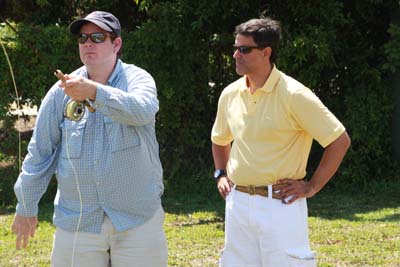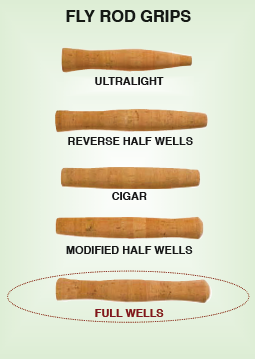Getting started – before you cast memorize the basics
by David Olson
[dropcap]I[/dropcap]’m amazed to see how many fly casters doom their efforts before they ever get started – by failing to prepare. The cure is simple, and easy to follow, and it doesn’t require any special talents.Get a grip

David (L) shows student at Fly Shop of Miami’s casting clinic how to grip the rod and cast properly.
The first thing you’ll need is a proper grip – your hand position affects your casting. Most saltwater rods are equipped with a full wells grips, featuring a thick center section that tapers on both ends to form a swale or well. The grip then flares at both ends. The idea is for the thumb to fit in the front well, while the heel of the hand occupies the rear depression. The flared cork ends keep the thumb and heel from slipping while casting. This design makes applying power easier: a major factor with big rods in the salt. In my opinion, the best way to hold a full wells grip is with the thumb directly on top of the rod. Since the thumb resists bending backward, you exert maximum force from that position. I find that when using this grip the rod tracks straighter. But I try not to squeeze the rod too tightly, as that can lead to a cramps, which reduces your ability to accelerate smoothly and make those sudden stops.
Stands to reason
How you stand is critical, too. By placing your lead foot (meaning the left one if you’re a right-hander) ahead of, and to the side of the other, you open your stance and achieve a greater range of motion. This also opens your shoulders and in so doing, lengthens your casting stroke. Think “the longer your cast, the wider your stance” to stay on track. Then, be sure that your rod, along with your rod hand, tracks back-and-forth on a perfectly straight line, rather than around your body as your shoulders rotate.
Don’t get high
I see this final mistake more-frequently than the others: It’s when anglers start out with their rods held high, which creates excessive slack between the rod tip and the water. Then they wonder why they can’t make a proper back cast, or get more line in the air. Here’s why in a nutshell: It’s important to start with the rod tip low – meaning at or near the surface – with your rod hand extended comfortably forward, after stripping-in any excess slack. Start-out like this and what’s the first thing you notice? You’ll move the fly when you move your hand, and reduce or eliminate any wasted energy. This also lengthens your range of motion, and lets you accelerate smoothly and stop your rod in the proper position.
Follow these simple instructions, and your casting will surely improve. Do it whenever you practice, and it becomes second-nature.
David Olson is a Federation of Fly Fishers Master Certified Casting Instructor with wins and placements in casting tournament competitions. He is also the managing partner of the Fly Shop of Miami.



